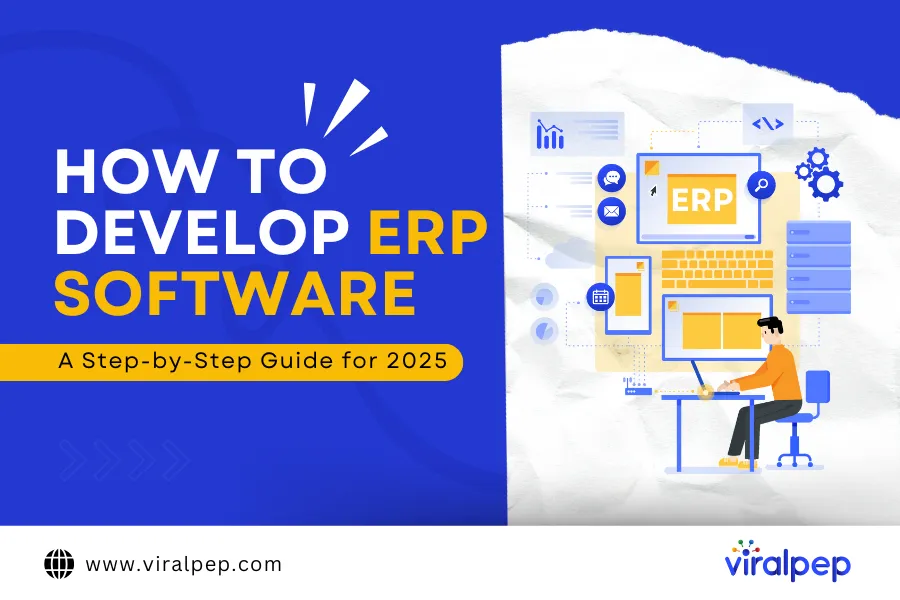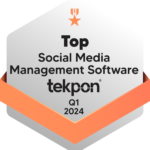Enterprise Resource Planning (ERP) systems are the hub around which current business operations function. In 2025, businesses are prioritizing ERP customization as part of emerging enterprise resource planning trends to stay competitive. They link together and improve areas such as finance, supply chain, HR, customer service, and project management.
Many companies use generic off-the-shelf ERP systems like SAP, Oracle, and Microsoft Dynamics. These platforms offer many capabilities but are not very flexible. Most organizations also find unnecessary features, integration problems, and limited expandability.
This raises an important question: Should you buy an ERP system, or is it better to create one?
This guide outlines the ERP development process in detail, covering the best ERP development practices for 2025 and how custom ERP solutions can improve efficiency. It also discusses how Viralpep, a leading social media management platform, can be integrated with ERP systems to enhance the decision-making processes of businesses when it comes to optimizing their digital marketing strategies.
Why Build a Custom ERP Instead of Buying One?
This is because while there are many ERP solutions in the market, businesses still prefer to develop their own system instead of purchasing one.
-
Customization and Business-Specific Features
Off-the-shelf ERP systems are general-purpose systems and therefore come with features that will be useful to most businesses and others that will be of no use. They also may not have some features that are critical to your industry.
With custom ERP software development, businesses can build applications that are specifically designed to meet their business processes.
-
Scalability for Business Growth
Pre-packaged ERP systems may be a good starting point but are often followed by expensive customizations and upgrades as the business grows.
A custom-built ERP system is built to grow with the business, and there are no additional charges for licensing.
-
Better Integration with Existing Tools
On top of that, most companies already use a number of other software applications to run their businesses.
It can be difficult and expensive to integrate an off-the-shelf ERP with these tools. With custom ERP development, organizations can build a system that can easily work with their current applications, including Viralpep for social media management.
-
Long-Term Cost Effectiveness
The cost of developing a custom ERP system is upfront, but this eliminates the costs of licensing fees, extra features, and vendor dependence in the long run.
Organizations that invest in a tailored ERP system do not have to worry about the future costs that come with modifying a generic system.
The Role of Social Media Management in ERP Systems
Today, social media plays an essential role in the business world—in branding, customer communication, and sales.
While traditional ERP systems are built around internal business processes, the integration of social media management tools provides organizations with a more holistic operational view.
This is where Viralpep comes in.
What is Viralpep?
Viralpep is a social media management system that provides businesses with the ability to schedule content, track engagement, and analyze the performance of their social media accounts across various platforms.
As a result, organizations can improve their management of digital marketing activities and link them to their overall business objectives through the integration of Viralpep with an ERP system.
Key Features of Viralpep:
- Content Scheduling – You can schedule and automate the posting of social media content across different channels from the control center.
- Analytics & Reporting – Get detailed performance data, measurement of interactions, and information about your audience.
- Team Collaboration– Manage tasks, get approval, and organize workflows for your social media activities.
How to Develop a Custom ERP System – A Step-by-Step Approach
Step 1: Planning and Requirement Analysis
Before starting, businesses must decide: Custom ERP vs off-the-shelf ERP—which is better? A custom ERP ensures flexibility, while pre-built solutions offer quick deployment. It is important to plan ahead when creating an ERP system to avoid costly modifications later.
Define Your Business Objectives:
State the main objectives of your ERP system. Common objectives include:
- Automating financial processes and reporting.
- Controlling and improving supply chain and inventory management.
- Improving sales and marketing analytics.
- Enhancing human resource management.
- Integrating digital marketing tools like Viralpep.
List Essential ERP Features:
Every business has unique needs, but common ERP features include:
- Finance & Accounting – Budgeting, payroll, invoicing, and tax reporting.
- HR & Employee Management – Onboarding, performance evaluation, and payroll.
- Supply Chain & Inventory – Vendor management, order tracking, and stock management.
- CRM (Customer Relationship Management) – Sales automation, customer data management.
- Project Management – Task tracking, workflow automation.
All are crucial elements of business process automation that help companies improve efficiency.
Step 2: Choosing the Best Technology Stack
This is because the performance, scalability, and security of your ERP are dependent on the technology stack you choose.
Common Technology Stack Options:
- Backend: Python (Django, Flask), Node.js, Java (Spring Boot)
- Frontend: React.js, Vue.js, Angular
- Database: PostgreSQL, MySQL, MongoDB
- Cloud Services: AWS, Azure, Google Cloud
- Security Measures: Role-based access control (RBAC), multi-factor authentication (MFA), data encryption
If your business is connected with digital marketing, you should include Viralpep’s API in the ERP system to integrate social media management among other business functions.
Step 3: Developing the ERP System Architecture
Here is how ERP systems are designed from an architectural perspective.
Monolithic Architecture
- Easier to create and deploy initially.
- Easier to debug and maintain.
- Less flexible for scaling and future modifications.
Microservices Architecture
- More flexible and scalable.
- More opportunities for single module improvements without affecting others.
- More challenging development approach.
For companies that want to link several external tools such as Viralpep, the microservices approach is generally the most suitable. It ensures that each ERP module can be scaled and improved independently.
Step 4: ERP Development Process
a) Develop the Minimum Viable Product (MVP)
It is not recommended to develop a full-fledged system at the beginning; rather, it is better to start with an MVP (Minimum Viable Product).
An MVP is a basic version of the system that has the most important features and can be used by businesses to:
- Get early feedback from real-world users and test the system’s functionality.
- Minimize development costs.
- Ensure that the ERP system is useful and practical for real business use.
b) Backend and Frontend Development
Once the MVP is successful, the full ERP development process starts.
- Backend engineers work on the business logic, API, and database.
- Frontend engineers focus on UI development.
c) Integration with Current Business Tools
To ensure smooth operations, the ERP system must integrate with existing tools such as:
- CRM software.
- Accounting platforms.
- Warehouse management systems.
- Social media management tools such as Viralpep.
Step 5: Testing, Deployment, and Maintenance
Testing Process
Thorough testing of the ERP system is crucial before its release.
- Functional Testing – Ensures all modules work as expected.
- Security Testing – Identifies vulnerabilities to prevent threats and data breaches.
- Performance Testing – Confirms that the system can handle peak loads efficiently.
Deployment Strategies
Here are different ways an ERP system can be deployed:
- Big Bang Deployment: The system is released to the entire organization at once. (High risk, but fast.)
- Phased Rollout: New features are added gradually. (Low risk, allows users to adapt over time.)
- Parallel Deployment: Both the old and new systems run simultaneously until the full switch is made.
Most organizations prefer a phased rollout, as it causes minimal disruption to business operations.
Ongoing Maintenance & Scaling
ERP systems require continuous improvement to remain relevant. This includes:
- Routine maintenance and bug fixes.
- Security upgrades.
- Adding new features based on evolving business needs.
- Optimizing system performance to improve efficiency.
Conclusion: Is Custom ERP Development Worth It?
For organizations with specific business processes, developing a custom ERP system tailored to their needs offers several advantages:
- Total control over features and integrations.
- Higher scalability for long-term growth.
- Overall cost-effectiveness compared to modifying an off-the-shelf system.
With Viralpep, a custom ERP can help businesses manage their social media campaigns, track the effectiveness of their digital marketing strategies, and engage with customers—all within one system.
If you are planning to develop an ERP,
- Start with small increments,
- Implement features based on real-world data, and
- Gradually build up the system.
The result? A fully customized ERP that enhances efficiency, optimizes workflows, and drives business success.
Looking to integrate social media with your ERP system? Try Viralpep today to streamline your digital marketing and enhance business decision-making. Start your free trial now.












